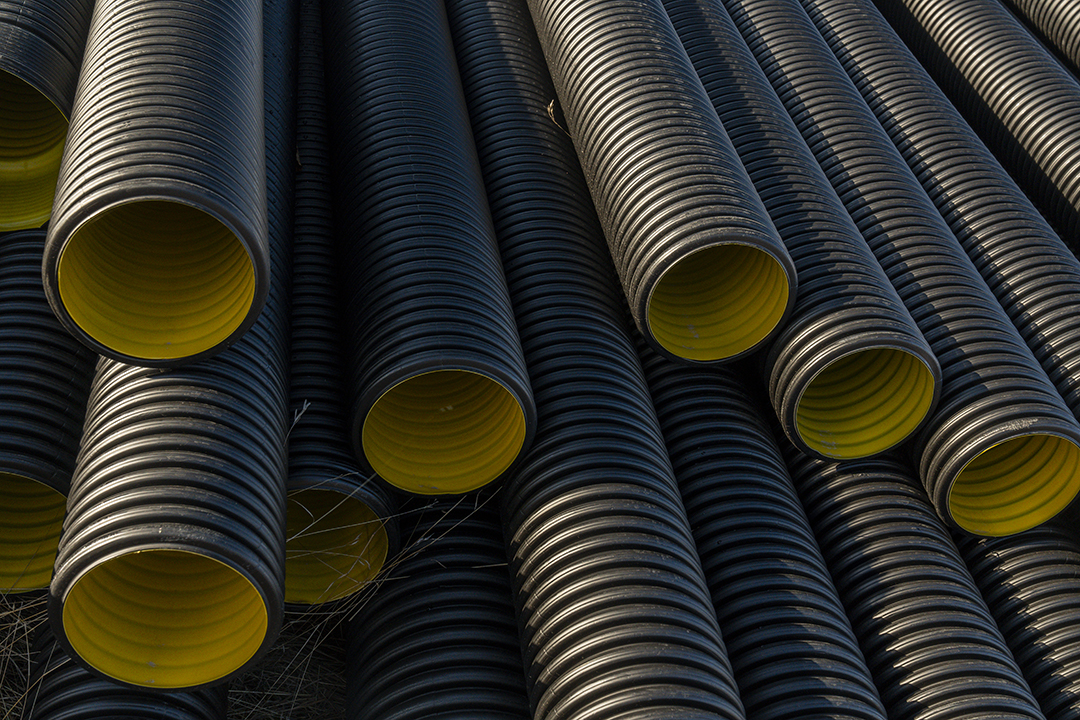High-Density Polyethylene (HDPE) pipes are widely used across various industries due to their durability, flexibility, and chemical resistance. HDPE piping serves as a reliable choice in applications ranging from the oil and gas industry to water treatment facilities. Selecting the correct size and HDPE pipe wall thickness is vital to ensure optimal performance and longevity in these demanding environments.
HDPE Pipe Sizes and Standards for Residential Construction and Large-Scale Industrial Needs
HDPE pipes are manufactured to meet specific standards and sizing requirements, making them versatile for diverse industrial applications. Different industries have unique requirements based on the conditions in which the pipes are used, such as pressure, temperature, and chemical exposure. To accommodate these needs, HDPE pipes come in various sizing standards that help guarantee compatibility and reliability in specific applications.
Several HDPE pipe classification systems are used to categorize pipes, each suited to particular environments and requirements:
- IPS (Iron Pipe Size): Commonly used in industries such as oil and gas gathering, mining, and some potable and wastewater applications. The IPS sizing system has long been a standard, providing consistency in sizing for pipes exposed to challenging conditions.
- DIPS (Ductile Iron Pipe Size): Primarily found in potable water and sewer systems, the DIPS standard is designed for applications where a stable inside diameter is critical, ensuring smooth flow and compatibility with ductile iron pipe infrastructure.
- CTS (Copper Tubing Size): This standard is used for smaller-diameter piping, commonly in gas distribution and potable water services. CTS pipes are chosen for applications where precise and smaller diameters are beneficial for efficient flow in confined spaces.
- SIDR (Standard Inside Diameter Ratio): Predominantly used in conduit applications where a consistent inside diameter (ID) is required. SIDR pipes are occasionally used for water applications but are gradually being phased out in many standards due to evolving industry requirements.
Beyond these standards, HDPE pipes are also categorized by their Nominal Pipe Size (NPS) or Diameter Nominal (DN). These measurements address a range of applications, allowing HDPE pipes to serve projects that range from residential construction to large industrial operations:
- Small Diameter Pipes (20 mm to 32 mm): Typically used in residential construction water supplies and micro-irrigation systems where low pressure and flexibility are sufficient.
- Medium Diameter Pipes (50 mm to 110 mm): Suitable for larger irrigation systems, municipal water supplies, and drainage applications where moderate pressure and a larger capacity are required.
- Large Diameter Pipes (110 mm and above): Commonly utilized in high-demand applications, including firewater systems, municipal water mains, and industrial effluent conduits. Sizes can reach up to 1600 mm (63 inches), making them ideal for extensive industrial and municipal needs where high capacity and durability are essential.
HDPE Pipe Wall Thickness and Standard Dimension Ratios (SDR)
The HDPE wall thickness, represented by the Standard Dimension Ratio (SDR), determines the pipe’s strength and pressure capacity. SDR is calculated as the ratio of the pipe’s outside diameter to its wall thickness. A lower SDR means thicker walls, which allow the pipe to withstand higher pressures and align closely with pipe sizes and pressure ratings across industrial applications.
- SDR11: Designed for high-pressure applications, commonly used in industrial systems requiring robust HDPE wall thickness.
- SDR17: Thinner walls, ideal for lower-pressure situations in irrigation and municipal water supply applications.
For example, an HDPE pipe with an outside diameter of 8 inches and a wall thickness of 0.4 inches has an SDR of 20, meeting the necessary thickness of the pipe schedule to withstand its designated pressure. This precise relationship between outside diameter and HDPE pipe wall thickness ensures that pipes meet diverse needs across industrial projects.
What is the Outside Diameter and Inside Diameter?
Outside Diameter (OD) and Inside Diameter (ID) are key measurements in HDPE piping, impacting compatibility, flow capacity, and pressure performance.
Outside Diameter (OD)
OD is the total width of the pipe measured across its outer edges, essential for fitting pipes with connectors and clamps. Standardized OD measurements, like those in Iron Pipe Size (IPS) and Ductile Iron Pipe Size (DIPS) systems, help ensure compatibility across applications.
Inside Diameter (ID)
ID represents the internal width of the pipe, directly affecting flow capacity. It is calculated by subtracting twice the wall thickness from the OD:
ID = OD – 2 × Wall Thickness
OD, ID, and Wall Thickness Relationship
The wall thickness impacts both ID and pressure resistance. Thicker walls mean a smaller ID but higher pressure capacity, while thinner walls allow a larger ID for lower-pressure applications. This balance is represented by the Standard Dimension Ratio (SDR), where a lower SDR indicates thicker walls and greater pressure resistance.
Accurate OD measurements ensure compatibility with standard fittings, reducing leak risks, while a precise ID allows for accurate flow rate calculations to meet system performance needs. Understanding the relationship between OD, ID, and wall thickness is necessary to select pipes that can handle specific pressure requirements, allowing for an informed HDPE pipe selection across industrial applications.
Pipe Schedule and Thickness for Pressure Ratings and Application Considerations
HDPE pipes are classified by pressure ratings, also known as Pressure Nominal (PN) values, which indicate the maximum internal pressure the pipe can safely handle. Selecting the right pipe schedule and thickness is important if you want to obtain the desired performance:
- PN6: Suited for low-pressure applications, such as residential water supply, where lighter HDPE wall thickness suffices.
- PN32: Designed for high-pressure scenarios, often used in industrial processes that require greater thickness of pipe schedule for safety and durability.
These ratings guide users in choosing HDPE pipes for specific applications, accounting for operational pressure, fluid type, and environmental factors, including temperature tolerance, which typically ranges from -40°C to +60°C.
Summary of HDPE Pipe Specifications
HDPE pipes are available in various sizes, each suited to specific applications and pressure requirements. The following table provides an overview of common HDPE pipe sizes, their typical uses, standard SDR values, and corresponding pressure ratings (PN).
| Pipe Size Range | Typical Applications | Common SDR Values | Pressure Ratings (PN) |
| 20 mm – 32 mm | Residential water supply, micro-irrigation. | SDR11, SDR17 | PN6 – PN16 |
| 50 mm – 110 mm | Municipal water supply, drainage. | SDR11, SDR17 | PN10 – PN25 |
| Above 110 mm | Firewater systems, industrial applications. | SDR11, SDR13.5 | PN16 – PN32 |
Benefits of HDPE Piping in Industrial Applications
HDPE piping offers extensive benefits, including resistance to corrosion, flexibility, and strength, making it ideal for applications that demand low-maintenance, durable solutions. Key applications include:
- Potable Water Distribution: HDPE pipes are non-corrosive, preserving water quality and minimizing contamination risks.
- Wastewater Management: The smooth inner surface of HDPE pipes resists chemical buildup and biofouling.
- Mining and Industrial Systems: Its chemical resistance allows HDPE to safely transport abrasive or acidic substances.
- Oil and Gas Gathering: HDPE pipes meet the high-pressure requirements of harsh oil and gas environments.
Why Coastal Resource Group is the Ideal Partner for HDPE Piping
Coastal Resource Group supports industries across Texas with a dependable supply of HDPE piping, fusion machines, and essential equipment, ensuring efficient, reliable solutions for a wide range of applications. Our services and inventory are designed to keep projects running smoothly and meet the unique demands of each industry we serve.
Our HDPE piping solutions are suited to a variety of applications, including downstream and midstream operations, drainage and wastewater systems, geothermal heating and cooling, industrial process piping, mining slurry transport, natural gas and potable water distribution, and sewage systems.
We offer a comprehensive range of products and services to support your needs, including:
- HDPE & Polypipe;
- Industrial Bolts & Flanges;
- Fusion Machine Rentals;
- Industrial Safety and PPE;
- Pipe Valves and Fittings;
- Industrial Hoses and Fittings;
- Industrial Consumables including Fasteners, Welding Supplies, and MRO;
- Tools and Equipment; and
- Industrial Rigging Equipment.
We proudly serve clients across sectors such as chemical processing, construction, food and beverage, mining, oil & gas, and water treatment facilities.
With strategic locations in Seguin for Central and West Texas and Houston for East Texas, we’re well-positioned to serve industries across the region.
Trust Coastal Resource Group for quality HDPE piping solutions and industrial supplies that ensure project success. Contact us today to discuss your requirements.


